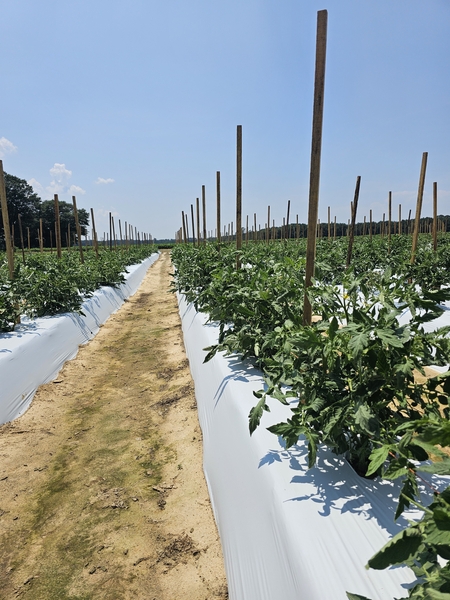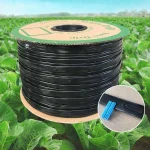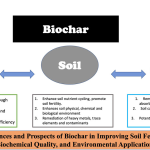Struggling to keep your garden lush without drowning in water bills? Discover the secret weapon that savvy gardeners use to cut back on irrigation: mulch.
You might be wondering how something as simple as mulch can transform your watering routine. It’s not just about aesthetics; it’s about creating a sustainable environment for your plants. Imagine having a thriving garden that requires less effort and fewer resources.
Intrigued? Dive into this guide to learn how you can harness the power of mulch to save time, conserve water, and still have the vibrant garden you’ve always wanted. Don’t miss out on these tips that could change your gardening game forever.

Benefits Of Mulching
Mulching is a simple gardening technique that offers many advantages. It involves covering the soil surface with materials like leaves, straw, or bark. This practice can greatly reduce the need for frequent irrigation. Mulching helps retain moisture, keeps the soil cool, and suppresses weed growth.
Using mulch can lead to healthier plant growth. It keeps the soil moist by slowing water evaporation. This means less watering is required, saving time and resources. Mulch also protects the soil from erosion and compaction. It acts as a barrier against harsh weather conditions.
Improved Soil Quality
Mulch adds organic matter to the soil as it breaks down. This enriches the soil, improving nutrient availability for plants. It encourages beneficial microorganisms to thrive, enhancing soil health. Healthier soil promotes stronger plant roots and better growth.
Weed Suppression
Mulch acts as a physical barrier against weeds. It blocks sunlight, preventing weed seeds from germinating. This reduces competition for nutrients and water. Less weeds mean less time spent on maintenance and more focus on growing healthy plants.
Temperature Regulation
Mulch helps regulate soil temperature throughout the year. In summer, it keeps the soil cool, preventing stress on plants. In winter, it provides insulation, protecting roots from freezing. Consistent temperatures promote steady growth and reduce plant stress.

Choosing The Right Mulch
Mulching is an effective way to conserve water in gardens. Choosing the right mulch enhances its benefits. It helps retain moisture and reduces irrigation needs. The right mulch can make a big difference in your garden.
Understanding Mulch Types
Organic and inorganic mulches serve different purposes. Organic mulches include wood chips, straw, and leaves. They break down over time, enriching the soil. Inorganic mulches include stones and plastic sheeting. They do not decompose but control weeds.
Benefits Of Organic Mulch
Organic mulch improves soil health. It adds nutrients as it decomposes. This type of mulch keeps the soil cooler. It also enhances water retention.
Advantages Of Inorganic Mulch
Inorganic mulch is low maintenance. It does not need frequent replacement. This type of mulch is ideal for decorative purposes. It also effectively suppresses weed growth.
Factors To Consider
Consider your climate when selecting mulch. In hot climates, organic mulch helps keep the soil cool. For decorative areas, inorganic mulch may be best. Also, think about the garden’s needs and your preferences.
Application Tips
Apply mulch evenly around plants. Keep mulch away from plant stems to prevent rot. A layer of two to four inches is ideal. This depth ensures effective moisture retention.
Mulching Techniques For Water Conservation
Mulching helps conserve water by reducing evaporation from soil. Organic materials like straw or bark cover the ground, keeping moisture in. This technique decreases the need for frequent irrigation and supports healthier plants.
Mulching Techniques for Water Conservation Have you ever thought about how much water you could save in your garden just by using mulch? With the right mulching techniques, you can reduce your irrigation needs significantly. This not only conserves water but also keeps your garden healthy and lush. ###Choose The Right Type Of Mulch
Selecting the right mulch is crucial for water conservation. Organic mulches like straw, shredded leaves, and wood chips break down over time, improving soil structure and moisture retention. Consider your local climate and the specific needs of your plants when choosing a mulch type. ###Proper Mulch Application
Apply mulch properly to maximize water conservation. Spread a 2-3 inch layer of mulch around your plants, ensuring it’s not piled against the stems. This helps retain moisture in the soil and prevents evaporation. When I first tried this, I noticed my plants were healthier and needed less water within weeks. ###Maintain Mulch Layer
Maintaining the mulch layer is essential for ongoing water conservation. Mulch can decompose or get displaced over time. Regularly check and replenish the mulch layer to ensure it stays at the optimal depth. ###Use Mulch To Create Moisture Zones
Create moisture zones by using mulch to delineate different areas of your garden. Focus more mulch where your thirsty plants are located. This targeted approach helps you manage water more efficiently, ensuring each plant receives the right amount of moisture. ###Observe And Adjust
Every garden is unique. Observe how your plants respond to the mulch and adjust accordingly. Are your plants thriving with less water? Do you notice any areas where mulch isn’t as effective? Use these observations to fine-tune your approach. Have you tried mulching for water conservation in your garden? What results did you notice? By sharing your experiences and insights, you can help others create more sustainable gardens.Maintaining Mulch For Maximum Efficiency
Mulch does more than just add beauty to your garden. It helps retain moisture. This reduces the need for frequent watering. But, mulch needs care to work well. Regular maintenance keeps it effective. It also ensures your plants thrive. Below, learn how to maintain mulch for best results.
Inspect Mulch Regularly
Check your mulch every few weeks. Look for signs of decomposition. Old mulch breaks down over time. This reduces its thickness. When mulch thins out, it loses efficiency. Add more mulch to maintain the right depth. About 2-3 inches is ideal.
Avoid Mulch Compaction
Mulch can compact over time. Compacted mulch limits water absorption. It also reduces air flow to the roots. Gently fluff the mulch with a rake. This helps it stay loose and airy. Your plants will thank you.
Keep Mulch Clean
Remove leaves and debris from mulch. This prevents mold and pests. Mold can harm your plants. Pests may hide in debris. A clean mulch bed keeps your garden healthy.
Replenish Mulch Annually
Mulch breaks down naturally. Replenish it once a year. Fall or spring is a good time. Fresh mulch maintains moisture control. It also provides insulation for plant roots.
Mind The Weather
Heavy rains can wash mulch away. Check mulch after storms. Replace any washed away sections. This ensures consistent coverage. It also keeps your garden looking neat.
Conclusion
Mulching is a simple way to save water in your garden. It keeps moisture in the soil, reducing the need for frequent watering. Mulch also helps protect plants from extreme temperatures. Use organic materials like wood chips or straw for best results.
Spread it evenly around plants, leaving space near stems. This easy step leads to healthier plants and a more sustainable garden. Try mulching today and see the difference it makes. Happy gardening!



